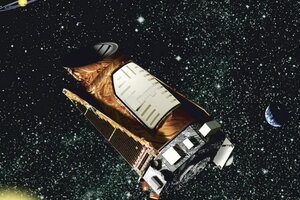Kepler revival plan advances to next vetting stage
The Kepler team’s proposed mission for the hobbled telescope must now compete with other astrophysics missions for a share of NASA's funds.

Kepler has been inactive since this summer, when problems with two of its four pointing wheels were declared unfixable. But the craft's scientists have proposed another plan to keep the telescope watching the skies and finding planets - perhaps, as the ultimate goal, one with life on it.
NASA/AP
There could be life yet in this life-hunting telescope.
The Kepler team’s proposed revival mission for the hobbled telescope, once charged with staring at the skies for possible life-hosting planets, will advance to the next stage of the mission vetting process, NASA has announced.
The new proposal, called “K2,” will be included in The Senior Review Committee’s evaluation of astrophysics missions this spring, NASA said. The space agency will use the committee’s findings to determine which astrophysics missions will receive funding over the next two years.
“To be clear, this is not a decision to continue operating the Kepler spacecraft or to conduct a two-wheel extended mission,” NASA said in a statement. “It is merely an opportunity to write another proposal and compete against the Astrophysics division's other projects for the limited funding available for astrophysics operating missions.”
The Senior Review Committee meets once every two years to evaluate how to allocate NASA’s budget between its astrophysics missions. The next committee meeting in the spring of 2014 will recommend to NASA the missions that should receive funding for the 2015 and 2016 fiscal years.
Kepler has been out of commission since May 2013, when a failure in two of the four wheels in its pointing system left the craft defenseless against the subtle push of the sunlight hitting it.
Sunlight's push is subtle, but it is just enough to upset the exacting precision with which Kepler must be oriented toward light-years-off stars ringed with possible planets. It is also just enough of a push that NASA announced in August that the problem was not fixable. Kepler would no longer hunt for planets, and future discoveries would have to come from the amassed data with which the defunct Kepler was leaving astronomers, as something of a solemn parting gift.
Kepler was launched in March 2009 with a bold, even romantic goal: to find, somewhere in the cosmos, a planet like Earth that had something or someone on it that might dull Earth-dwellers’ loneliness in the cosmos. For four years, the telescope watched 150,000 stars in the constellations Cygnus and Lyra and, around them, alighted on about 3,500 possible planets. Some of these planets host lava seas, or rain glass sideways, or finish up a year in less than 8 hours. Most of them upend what astronomers had thought about solar systems beyond our own. None of them, as best as scientists know, seem to have life.
But, in November, a paper published in "Proceedings of the National Academy of Sciences" had boosted the odds of finding companionship off Earth. Based on extrapolations from Kepler data, about 22 percent of the sun-like stars in the galaxy might have a habitable planet – an Earth-sized planet in what is called its sun’s habitable zone, the orbital region where, hypothetically, the planet is neither too hot, nor too cold. That's 11 billion planets where life could, maybe, have arisen. But would Kepler be able to help find them?
Later that month, Kepler’s scientists announced that all might not be lost: the team had a new plan, called “K2.” Perhaps, the team said, the sunlight’s pernicious push could be deployed to Kepler’s advantage, helping to point and stabilize the telescope.
It seemed it could: a test run of the proposal in late October, in which Kepler was ordered to take a 30-minute exposure of stars in the constellation Sagittarius, produced an image within 5 percent of the quality of unhobbled Kepler’s pictures.
“We were astounded at how well it worked,” Charlie Sobeck, deputy project manager for the mission at NASA's Ames Research Center at Moffett Field, Calif, told the Christian Science Monitor in November.
When the revised Kepler project goes before the review committee, it will be vying for a share of NASA's funds against a number of other astrophysics missions, including Hubble, Chandra, Spitzer, and WISE. The last review meeting, in April 2012, had extended funding for all nine of the submitted astrophysics projects, including Kepler, which at the time at all four of its wheels.
“The Kepler team's proposal, dubbed K2, demonstrated a clever and feasible methodology for accurately controlling the Kepler spacecraft at the level of precision required for scientifically valuable data collection,” NASA said in a statement.
“The team must now further validate the concept and submit a Senior Review proposal that requests the funding necessary to continue the Kepler mission, with sufficient scientific justification to make it a viable option for the use of NASA's limited resources,” the space agency said.
Funding recommendations are made based on how productive the mission is expected to be over the next four years, NASA said.

